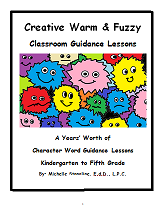Sand Tray: Midterm Part 2: Video Critique - J.
by Sand Tray Therapy Student
(Lawrenceville, GA)
The six videos from the Sandtray Therapy institute were extensive and comprehensive. The first three videos are very introductory starting with the reasoning behind using sandtray and its benefits and moving on to the actual practical consideration of the tray, sand, and miniatures, before moving on to talking the viewer through the sandtray session. There was something very appealing about this easing into the concept before the demonstrations begin. An important point made in this third video is the humanistic nature in the technique that Dr. Armstrong is teaching, pointing out that it is not all about what is in the tray, that the counselor needs to be as aware of the expressions, body language, or any other signals coming from the client and must be ready to key in on them as the session progresses. As a technical criticism of the videos depicting the session with Debbie, I did have trouble hearing Debbie, which I found a bit frustrating while watching the videos, however, I was able to follow what was going on from Dr. Armstrong’s side of the conversation and I did like seeing the technique in action in processing the sand tray. Probably the most useful and interesting of the videos for me, however, was the final one showing common mistakes. The first four of the six, particularly the drifting off-topic and interrupting an intense display of emotion, were mistakes that I am prone to making and it was good to see what these mistakes look like so that I can recognize and avoid them.
The Sandplay Therapy with Barbara Turner was another informative video. First of all, it was interesting in the opening to see the pictures of her shelves and the variety of miniatures that Dr. Turner has at her disposal. I’m a bit torn on the beginning of the video, after the introduction to Sandplay, which was very well done. It was interesting to see Dr. Turner create and then interpret her own tray at the beginning, particularly as that is something that I am doing in the class, but at the same time, I feel like I would have prefered more of a role play demonstration. I am eager to see some models of how to interact with a sand tray client and I missed that in the self administered session. The case vignettes were very interesting, particularly as it showed how multiple trays are used with a client. I also appreciated that the vignettes included one from a child client and one from an adult client to demonstrate how the process works with the different types of clients.
I mentioned wanting to see sand tray sessions modeled for me, and the “Sand Play Counseling Session for Training” video is that precisely. I’d contend that the best way to become comfortable and confident in doing something is to do it, but it is also nice to see it done in order to have a model on which to base that “doing,” at least initially. The therapist providing asides to explain what she was doing as she conducted the session was helpful. I was struck early on at the therapist saying that she was watching for the non-verbal signal for when the client was done. As a novice I’d be a little worried about jumping in too soon and interrupting the building process. At the moment I’m a bit more comfortable asking the client to give me a verbal cue when he/she is done. It was also interesting to see how this session that was created as a demonstration was very real, there was nothing “mock” about what was going on in this session. It does lend credence to the power of this technique to get at some real and sometimes submerged truths. I especially liked what the therapist/instructor said at the end of the video about thanking the client and about how being witness to the client’s world changes the therapist as well as the client. I found that to be very profound and that it definitely rang true.
“Adult Therapy in the Sandtray” is a brief video recreating a session with an adult client. Jill Weadick certainly has an impressive collection of miniatures for her use. It was interesting to hear about how the therapist conducted a session with an adult client. I can easily see how the sand tray would work with children, but I remain curious about its use with adults. It is not that I doubt that it would work with adults, I’m just curious about getting past the resistance an adult might have to using miniatures in the sand tray. It was also nice to see a simpler tray, even if it was specific to this client’s issue, after how full the trays in the other videos have been. I keep thinking back to how much empty space there has been in the trays I’ve done and was starting to worry I was holding back too much or something.
The five Jill Weadick videos covered a variety of different topics of interest. I was interested to hear the rationale behind the arrangement of her figurines. The practical concerns about putting the taller figureines on top of the shelves I would have thought of, but the thematic arrangement probably would not have occurred to me. It was also important to see that she had items beyond animals and human figures, but also shapes, different types of wood, etc. The interesting takeaway from the introduction, was the rationale for prefering the deeper tray. I would not have thought about the depth of the tray corresponding to how deep the client can reach into his/her consciousness. Seeing Jill Weadick’s daughter play in the sand tray was interesting, especially since I haven’t actually seen a child interact with a sand tray yet. I also found Weadick’s comments on how useful sand trays could be in other contexts for children. The description of the session with an adolescent was interesting, but I was once again wishing I could have seen some kind of reenactment of the session. I understand there are limits logistically to what could be done for these videos, but I’m still a little hungry to see what this interaction looked like.
Disclaimer: This website and its content is intended for trained licensed mental health professionals and school certified mental health professionals to use for their clients / students at their own discretion.
*If you ignore the disclaimer above are using these techniques on yourself and you feel any discomfort or upset it is highly suggested that you seek out a licensed mental health professional immediately.
"Beyond Art Therapy" is the concept from Dr. Stangline that combines all creative fields in therapy. It is not the traditional "art therapy" but goes beyond to include sand tray therapy, play therapy, mindfulness, meditation, color therapy, cognitive behavioral therapy, and a vast majority of other therapies.
For any other type of mental health emergency call your local 911 / Police Number immediately.
Dr. Stangline does not offer advice / suggestions to anyone who is not a professional mental health provider, or a student who is studying this field and has questions about mental health programs of study.
See our Exciting Selection of eBooks:
Award Winning:
Creative Counseling 101 eBook
Our Best Seller!
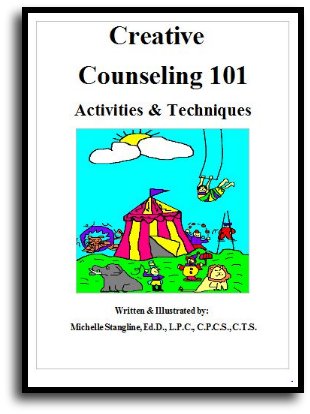
Step By Step Therapy:
Learn how to be a more Creative Therapist with the Book that started it all!
- Graduate School Counseling book used by hundreds of graduate counseling students!
- Includes full color reproducible worksheets with most activities.
- Winner of the Counselor Writer of the Year Award, 2011, Georgia Regional Award
Download Your Copy Today Only $39.95:
See Creative Counseling 101 eBook Information Here:
Get the Set
of all four
eBooks for only $98.95:
An incredible collection of how to do therapy eBooks!
A $159.80 Value,
You Save Over $60!
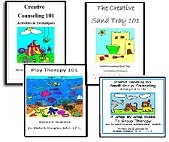
Get your complete set of the Creative Counseling 101.com eBooks by Dr. Michelle Stangline for only $98.95, that's less than $25.00 per eBook (Regular Price is $39.95 for each eBook.).
Your complete set includes:
- Creative Counseling 101
- Creative Group Counseling 101
- Creative Play Therapy 101
- Creative Sand Tray 101
For more information click the link below:
See Complete Set of eBooks For Sale Here:
New!!! "Beyond Art Therapy" 101 eBook
Over 300 pages of Beyond Art Therapy activities and techniques. Learn what I teach graduate counseling students!
See the link below for more information.
Only $39.95
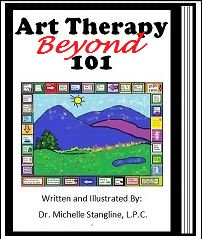
See More Invividual eBooks For Sale:
Sand Tray Therapy 101 eBook:
Learn how to do Sand Tray Therapy or enhance your skills.
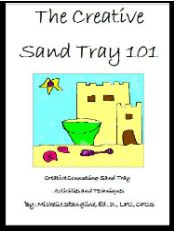
Play Therapy 101 eBook
Learn how to do play therapy or enhance your skills.
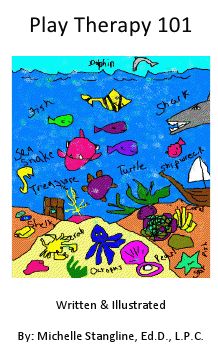
Small Group Counseling eBook For Sale:
Learn how to do creative group therapy and enhance your skills.
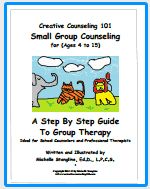
School Counselor Guidance Lesson & Social Stories eBook for sale:
Get a year's worth of school counselor guidance lessons with "Creative Warm & Fuzzy Classroom Guidance Lessons eBook". Introduce your students to the "Warm & Fuzzy Way". Click the link below for more information:
Warm & Fuzzy School Counselor Guidance Lessons eBook
